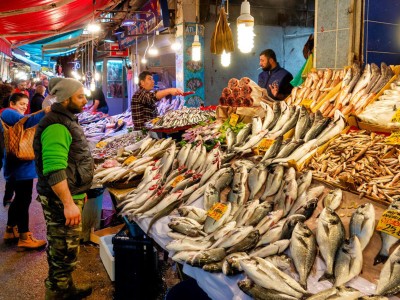
Pelagic fish from the open ocean are richer in nutrients than are chicken, beef, lamb and pork.Credit: Aaron Bull/Getty
Next week, world leaders will gather for the United Nations Food Systems Summit. The event will be hosted by UN secretary-general António Guterres, with the aim of giving a much-needed boost to efforts to get the agency’s flagship Sustainable Development Goals back on track.
One of these goals is to end hunger by 2030. Nearly 700 million people (almost 9% of the world’s population) go hungry; of those, 250 million are potentially on the brink of starvation, according to the World Food Programme. Even before COVID-19, there had been limited progress towards ending hunger. Unless the summit’s delegates take strong and coordinated action, 840 million will be going hungry by 2030.
This week, journals in the Nature Portfolio shine a spotlight on how aquatic food systems — sometimes called blue foods — can help to end hunger and accelerate the creation of a truly sustainable global food system (see go.nature.com/3nw8qbf).
The research is part of the Blue Food Assessment, a collaboration involving more than 100 researchers. It is the first systematic assessment of how aquatic food contributes to food security, helping to build a fuller picture of the global food system, beyond food from agriculture.
Blue foods include fish and shellfish, but also encompass the diversity of animals, plants and algae harvested from rivers, seas and the ocean, which provide protein and other valuable nutrients for more 3.2 billion people.
To improve understanding of their nutritional value, Christopher Golden at the Harvard T.H. Chan School of Public Health in Boston, Massachusetts, and his colleagues compiled nutrient profiles of 3,753 types of aquatic food (including fish, crustaceans and cephalopods). They found1 that several categories (including shellfish and fish from the open ocean) are, on average, richer than beef, lamb, chicken or pork in the seven nutrients assessed (omega-3 long-chain polyunsaturated fatty acids, vitamins A and B12, calcium, iodine, iron and zinc).
When blue is green
Globally, food production accounts for one-quarter of all greenhouse-gas emissions. However, Jessica Gephart at the American University in Washington DC and her colleagues2 found that some forms of farmed aquatic foods have lower emissions than do foods gathered or caught from the wild. For example, farmed bivalves (such as clams and oysters) and shrimp produce lower average emissions than their wild-caught counterparts.
A spotlight on seafood for global human nutrition
Globally, one billion people are fed by small-scale fisheries and aquaculture, which also support 100 million jobs for lone businesses and communities. Small-scale fisheries and aquaculture produce more than half of the world’s fish catch, and two-thirds of aquatic foods that people eat.
But, as Rebecca Short at the Stockholm Resilience Centre and her colleagues report3, these communities have been neglected, both by science and in policymaking. As Nature has highlighted before, people who work alone or in small cooperatives tend to lack access to government and policy processes, and are under-studied by researchers. Short and colleagues have produced 70 case studies from around the world that demonstrate the many ways in which blue foods are produced at smaller scales — from fishing to feed individual households to small businesses joining in networks, perhaps as part of a cooperative.
Coastal communities are often among their countries’ poorest, and most vulnerable — both to climate change and to changes in the global economy. Michelle Tigchelaar at the Center for Ocean Solutions at Stanford University in California and her colleagues combined data on climate hazards, exposure and vulnerability for 219 countries and territories to show that the aquatic food systems most at risk from climate change are in Africa, south and southeast Asia and the Indo-Pacific4.
Rapidly increasing demand for fish is also adding to risks for coastal communities. Demand has doubled since the start of the twenty-first century and — as Rosamond Naylor, also at Stanford, and her colleagues report — there will be another near-doubling by the middle of the century5. That will benefit some, whose incomes will increase, but it could reduce the protein consumption of others if there is less locally harvested fish available to eat or buy.
At a World Food Summit 25 years ago, some 10,000 participants from nearly 200 nations pledged to end hunger, with an immediate goal of halving the numbers of undernourished people by 2015. That did not happen. Before that, the 1974 World Food Conference in Rome boldly proclaimed that people have an “inalienable right to be free from hunger and malnutrition”. These were stirring words, but not accompanied by meaningful action.
Delegates at next week’s summit have another valuable opportunity to act so that history is not repeated. And they must recognize blue foods for their potential in ending hunger and helping the world to transition to a sustainable food system.

 Ending Hunger: Science must stop neglecting smallholder farmers
Ending Hunger: Science must stop neglecting smallholder farmers
 Imagine a world without hunger, then make it happen with systems thinking
Imagine a world without hunger, then make it happen with systems thinking
 A spotlight on seafood for global human nutrition
A spotlight on seafood for global human nutrition
 Read the paper: Aquatic foods to nourish nations
Read the paper: Aquatic foods to nourish nations


